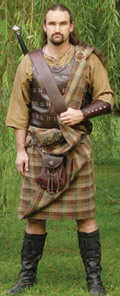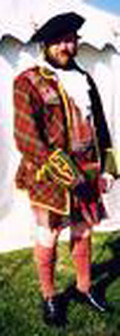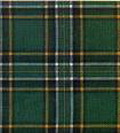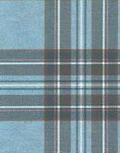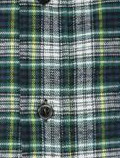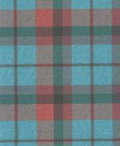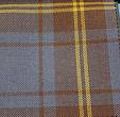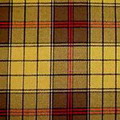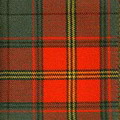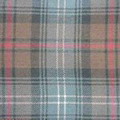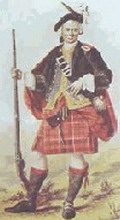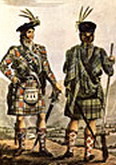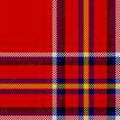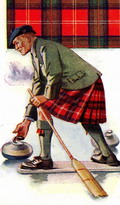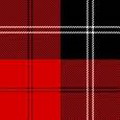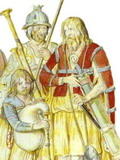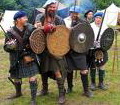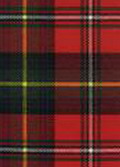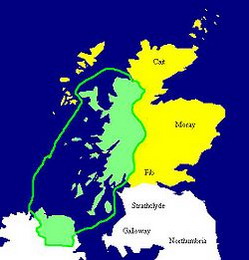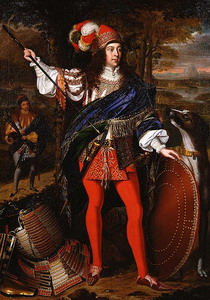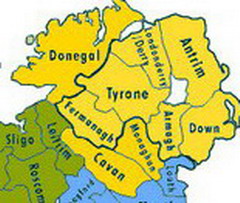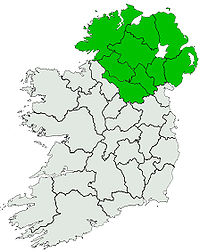|
Tartan and Ulster The Tartan Coat of Many Colors and Joseph This is Page 8 Continued from Page 7 |
8. Tartan in Ulster Tartan and UlsterContents: Part One: Welcome to Ulster Introduction The Ethnic Origins of Ulster: The Scotch-Irish and Yair of Manasseh Ulster: Extracts from Wikipedia History of Northern Ireland: Extracts from Wikipedia Linda Merle: DNA Genealogy and the Scots, Irish, and Scotch-Irish Part Two: Titanic Tartans and Clifford Smyth Ulster Tartan Parallels to Highland Dress in Morocco? Tartan Conveys a Message! The Sinking of the Titanic and Tartan? Kosher Jewish Tartan Designing Twelve New Tartans for Each Israelite Tribe? Does Tartan Bear an Ancestral Message?
Part One. Welcome to Ulster Introduction The aim of this article is to speak of Tartan and its use in North Ireland otherwise known as Ulster. We have chosen to use this opportunity to give background information concerning Ulster in general since it has an importance worth being aware of. The Ethnic Origins of Ulster: The Scotch-Irish and Yair of Manasseh The Protestant inhabitants of Ulster in North America are known as Scotch-Irish. More than 80% of all American Presidents are of predominant Scotch-Irish ancestry. Their ancestors migrated from Ulster. [J.F.K. Kennedy, Ronald Reagan, and Bill Clinton however came from Irish Catholic or Southern Irish forefathers as did some others.]
Descendants of Neil eventually were to be found in substantial numbers throughout all the former region of Ulster including what is now Protestant Northern Ireland and the predominantly Catholic areas now part of the Irish Republic (Eire). Later the English conquered Ulster along with the rest of Ireland. At that time the land was sparsely populated and so the English began to encourage immigration from elsewhere. This became known as the Plantation" system. These were mainly Protestants though they included some Scottish Catholic Highlanders. Most of the settlers came from Scotland. They came from both the Highlands and Lowlands but the Lowlanders were overwhelmingly predominant. They were joined by immigrants from England, Wales, Holland, France, and elsewhere. A good portion of the local Irish in the course of time by changing their religion or intermarriage were assimilated into the Ulster Protestant community. Ulster: Extracts from Wikipedia http://en.wikipedia.org/wiki/Ulster Extracts: Ulster (Irish:
Ulaidh
/ Cuige
Uladh,
Ulster Scots: Ulster) is one of the four Provinces of Ireland, located in the
north of the island.
Ulster is one of the four Irish provinces. Its name derives from the Irish language Cuige Uladh (pronounced "Kooi-gah UH-loo"), meaning "'fifth' of the Ulaidh", named for the ancient inhabitants of the region. In early medieval Ireland, the Ui Ne l (O'Neill) dynasty dominated Ulster from their base in Tir Eoghain (Eoghan's Country) most of which forms modern County Tyrone. The Domhnaill (O'Donnell) dynasty were Ulster's second most powerful clan from the early thirteenth-century through to the beginning of the seventeenth-century. The O'Donnells ruled over Tir Chonaill (most of modern County Donegal) in West Ulster. After the Norman invasion of Ireland in the twelfth century, the east of the province fell by conquest to Norman barons, first De Courcy (died 1219), then Hugh de Lacy (1176-1243), who founded the Earldom of Ulster based around the modern counties of Antrim and Down. However, by the end of the 15th century the Earldom had collapsed and Ulster had become the only Irish province completely outside of English control. Elizabeth I's English forces succeeded in subjugating Ulster and all of Ireland. The Gaelic leaders of Ulster, the O'Neills and O'Donnells, finding their power under English suzerainty limited, decamped en masse in 1607 (the Flight of the Earls) to Roman Catholic Europe. This allowed the English Crown to plant Ulster with more loyal English and Scottish planters, a process which began in earnest in 1610. Counties Donegal, Tyrone, Armagh, Cavan, Londonderry and Fermanagh comprised the official plantation. However, the most extensive settlement in Ulster of English, Scots and Welsh as well as Protestants from throughout the European continent... occurred in Antrim and Down. These counties, though not officially planted, had suffered de-population during the war and proved attractive to settlers from nearby Scotland. This unofficial settlement continued well into the 18th century.... The Protestant Ascendancy in Ireland excluded most of Ulster's population from power on religious grounds. Roman Catholics (descended from the indigenous Irish) and Presbyterians (mainly descended from Scottish planters, but also from indigenous Irishmen who converted to Presbyterianism) both suffered discrimination under the Penal Laws, which gave full political rights only to Anglican Protestants (mostly descended from English settlers). In the 1690s, Scottish Presbyterians became a majority in Ulster, tens of thousands of them having emigrated there to escape a famine in Scotland. Considerable numbers of Ulster-Scots just a few generations after arriving in Ulster migrated to the North American colonies throughout the 18th century (250,000 settled in what would become the United States between 1717 and 1770 alone). According to Kerby Miller, Emigrants and Exiles: Ireland and the Irish Exodus to North America (1988), Protestants were only one-third of the population of Ireland, but they comprised three-quarters of all emigrants from 1700 to 1776; 70% of these Protestants were Presbyterians. Author (and U.S. Senator) Jim Webb puts forth a thesis in his book Born Fighting to suggest that the character traits he ascribes to the Scots-Irish such as loyalty to kin, mistrust of governmental authority, and a propensity to bear arms, helped shape the American identity. In the United States Census, 2000, 4.3 million Americans claimed Scots-Irish ancestry, though James Webb suggests estimates that the true number of Scotch-Irish in the USA is more in the region of 27 million.[2] Interestingly, the areas where the most Americans reported themselves in the 2000 Census only as "American" with no further qualification (e.g. Kentucky, north-central Texas, and many other areas in the Southern US) are largely the areas where many Scots-Irish settled, and are in complementary distribution with the areas which most heavily report Scots-Irish ancestry. In the 19th century, Ulster became the most prosperous province in Ireland, with the only large-scale industrialisation in the country. In the latter part of the century, Belfast overtook Dublin as the largest city on the island. Belfast became famous in this period for its huge dockyards and shipbuilding and notably for the construction of the RMS Titanic.When the Irish Free State came into existence in 1922, the Northern Ireland Parliament (already in existence) was given the option to 'opt out', which it did. History of Northern Ireland http://en.wikipedia.org/wiki/History_of_Northern_Ireland From
Wikipedia,
the free encyclopedia
Once the bedrock of Irish resistance to the advance of the English state in Ireland, the Plantation of Ulster by Scottish and English colonists resulted in Northern Ireland following a different economic, religious and cultural trajectory to the rest of the island. The first years of the new autonomous region were marked by bitter violence, particularly in Belfast. The IRA was determined to oppose the partition of Ireland and the authorities created the (mainly ex-UVF) Ulster Special Constabulary to aid the Royal Irish Constabulary (RIC) and introduced emergency powers to put down the IRA. The continuing violence created a climate of fear in the new region, and there was migration across the new border. As well as movement of Protestants from the Free State into Northern Ireland, some Catholics fled south, leaving some of those who remained feeling isolated. ...the unionist establishment practised what is generally considered a policy of discrimination against the nationalist/Catholic minority. Emigration to seek employment was significantly more prevalent among the Catholic population. As a result, Northern Ireland's demography shifted further in favour of Protestants leaving their ascendancy seemingly impregnable by the late 1950s. The following thirty years of civil strife came to be known as the Troubles. The appearance in 1970 of the Provisional IRA, a breakaway from the increasingly Marxist Official IRA, and a campaign of violence by loyalist paramilitary groups like the Ulster Defence Association and others brought Northern Ireland to the brink of civil war. On 30 March 1972, the British government, unwilling to grant the unionist Northern Ireland government more authoritarian special powers, and now convinced of its inability to restore order, pushed through emergency legislation that prorogued the Northern Ireland Parliament and introduced direct rule from London.[14] In 1973 the British Government dissolved the Parliament of Northern Ireland and its government under the Northern Ireland Constitution Act 1973. The British government held talks with various parties, including the Provisional IRA, during 1972 and 1973. (The Official IRA declared a ceasefire in 1972, and eventually ended violence altogether, although a breakaway group, the Irish National Liberation Army, continued with a campaign of violence. The Provisional IRA, however, remained the largest and most effective nationalist paramilitary group.) The worst fear envisaged a civil war which would engulf not just Northern Ireland, but also the Republic of Ireland and Scotland, both of which had major links with either or both communities. On July 28, 2005, the IRA made a public statement ordering an end to the armed campaign and instructing its members to dump arms and to pursue purely political programmes. On 8th May 2007, home rule returned to Northern Ireland. DUP leader Ian Paisley and Sinn Fein's Martin McGuinness took office as First Minister and Deputy First Minister, respectively. (BBC). Linda Merle: DNA Genealogy and the Scots, Irish, and Scotch-Irish From the point of view of DNA: http://listsearches.rootsweb.com/th/read/Scotch-Irish/2009-01/1231369481 Linda Merle says: |
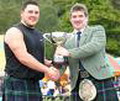
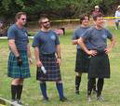
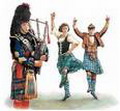
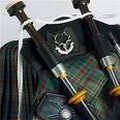
|
